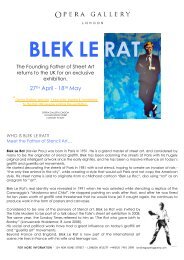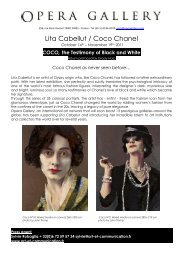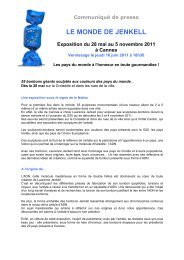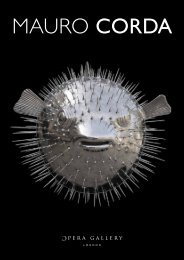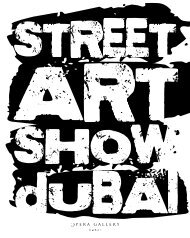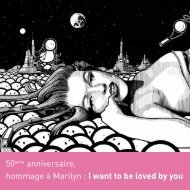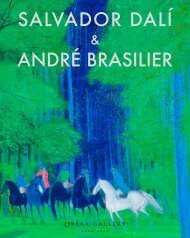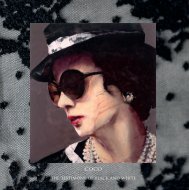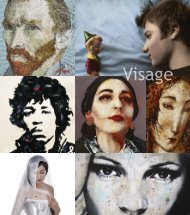Download - Opera Gallery
Download - Opera Gallery
Download - Opera Gallery
You also want an ePaper? Increase the reach of your titles
YUMPU automatically turns print PDFs into web optimized ePapers that Google loves.
FRANCESCA LEONE<br />
beyond the water<br />
essay by<br />
Christopher Adams<br />
IL CIGNO GG EDIZIONI<br />
ROMA
FRANCESCA LEONE<br />
beyond the water<br />
contents<br />
essay by<br />
Christopher Adams<br />
20 September - 10 October 2012<br />
<strong>Opera</strong> <strong>Gallery</strong> London<br />
134 New Bond Street<br />
London W1S 2TF, United Kingdom<br />
photographs<br />
Marco Palombi<br />
Fausto Capalbo<br />
Press Il Cigno GG Edizioni<br />
Maria Letizia Cassata<br />
the artist wishes to thank<br />
her beloved sister Raffaella<br />
foreword 7<br />
Jean-David Malat<br />
Director, <strong>Opera</strong> <strong>Gallery</strong> London<br />
Gilles Dyan<br />
Founder and Chairman, <strong>Opera</strong> <strong>Gallery</strong> Group<br />
francesca leone: motion / emotion 9<br />
Christopher Adams<br />
Assistant Curator, Estorick Collection of Modern Italian Art<br />
flussi immobili 15<br />
flussi immobili materici 45<br />
biography 63<br />
list of works 66<br />
front cover<br />
Flussi Immobili L (Upside down)<br />
2012, paper, sand, plastic, oil, bitumen<br />
on canvas, 250 x 190 cm<br />
ISBN 978-88-7831-287-6<br />
All rights reserved<br />
©2012 IL CIGNO GG EDIZIONI, ROMA<br />
IL CIGNO GG EDIZIONI<br />
Piazza San Salvatore in Lauro, 15 00186 Roma<br />
Tel +39/066865493 fax +39/066892109<br />
www.ilcigno.org<br />
sito nel Complesso Monumentale di San Salvatore in Lauro<br />
un immobile dell’Ente morale Pio Sodalizio dei Piceni
FOREWORD<br />
The new series of Francesca Leone’s large-scale emotional portraits is<br />
presented at <strong>Opera</strong> <strong>Gallery</strong> London for the reopening of the art season, after<br />
all the hubbub of the Olympic Games and the summer period.<br />
It is with great pleasure that we exhibit the work of a committed artist whose<br />
relentless search for emotion and humanity goes deep under the skin of her<br />
subjects.<br />
The passion within the layers of paint, the intensity of the close-ups, the power<br />
of the brushstrokes and the mastered technique of representation…all these<br />
elements take Francesca Leone’s work a big step further than traditional<br />
portraiture, and make her work so eye-catching to a public of art lovers and<br />
emotion seekers.<br />
When I asked Francesca why she chose to represent her subjects as if<br />
drenched under litres of water, she replied: “For the vulnerability. When<br />
someone is thrown water at, they lose all self-control, all façade protection.<br />
The water washes everything away and the only thing that is left is the raw<br />
and true human nature”.<br />
This exhibition is therefore much more than a painting display; it is truly an<br />
exhibition of the human, a series of paintings depicting the souls behind the faces.<br />
We are very proud to provide the walls that will bear these souls for the time<br />
of an exceptional show.<br />
Jean-David Malat<br />
Director<br />
<strong>Opera</strong> <strong>Gallery</strong> London<br />
Gilles Dyan<br />
Founder and Chairman<br />
<strong>Opera</strong> <strong>Gallery</strong> Group<br />
7
FRANCESCA LEONE: MOTION / EMOTION<br />
On first acquaintance with these new works by Francesca Leone, one could be<br />
forgiven for thinking that they are solely concerned with the inherent irony of<br />
attempting to capture movement in a static medium – something summarised<br />
in the paradoxical title given to the pieces: Immobile Flux. It is an irony that<br />
one might suppose would naturally be appreciated by a painter immersed from<br />
an early age in the world of ‘motion pictures’, which also rely on still images to<br />
generate a convincing illusion of movement – albeit a vast number, presented<br />
to the viewer in rapid succession, in contrast to the painter’s single rectangular<br />
expanse of canvas. Leone’s use of photography as the point of departure for<br />
her works – with its unique ability to arrest motion – would only appear to<br />
reinforce this interpretation.<br />
And yet whilst her choice of flowing water as subject matter reveals an interest<br />
in a problem that has occupied artists for centuries, and which particularly<br />
fascinated the Italian avant-garde in the early years of the twentieth Century,<br />
it would be a mistake to see it as the overriding focus of these images. Indeed,<br />
if it were so they would be far less interesting than they actually are. Rather, it<br />
is their equal attention to the psychological dynamics of the frozen image that<br />
makes the works displayed in the present exhibition so compelling.<br />
It seems relevant at this point to recall Goethe’s notion of the ‘fugitive moment’:<br />
that precise point during the performance of an action that is carefully selected<br />
by the painter for its ability to encompass an altogether wider temporal scope and<br />
convey a sense of animation by implying both the sequence of events or<br />
movements leading up to that point, and those which must necessarily follow it.<br />
In looking at a work such as Emotionless, for instance, we understand that we<br />
are viewing the features of man through a (moving) stream of water rather than<br />
a (static) sheet of ice; our knowledge of this fact endows the image with an<br />
unstable quality, in keeping with Goethe’s recommendation that ‘no part of the<br />
whole ought to be found before in this position and, in a little time after, every part<br />
should be obliged to quit that position; it is by this means that the work be always<br />
animated for millions of spectators’ 1 . However, what is true for the physical acts<br />
depicted in an artwork is also true for its metaphysical aspects: a single ‘moment’<br />
likewise being able to contain a broader emotional sweep than one ‘pitched<br />
upon’ 2 with less judiciousness, communicating to the attentive viewer the full<br />
complexity of an emotional state – or rather, psychological flux.<br />
1<br />
Johann Wolfgang von Goethe, ‘Observations on the Laocoon’, in Goethe on Art, ed. by John Gage (Berkeley<br />
and Los Angeles: University of California Press, 1980), pp. 78-88 (p. 81).<br />
2<br />
Ibid.<br />
9
It is, then, this expansive nature of the frozen image – both in terms of its ability<br />
to say something about ‘universal dynamism’, and to pinpoint something<br />
decisive about an individual’s fluid ‘state of mind’ – that would appear to interest<br />
Leone here, and which is encompassed in the title of this exhibition.<br />
In the latter sense, nothing exemplifies this ‘telescopic’ potential of still imagery<br />
better than the photographic snapshot. Such images tend to increase in potency<br />
the longer we look at them, revealing fluctuating areas of light and shade in the<br />
expressions and attitudes of individuals that are brought into sharper focus the<br />
more closely acquainted we become with their complex personalities in real<br />
life. This is surely part of the reason why we choose to surround ourselves with<br />
images of loved ones that are of this nature, rather than with more controlled,<br />
formal portraits, which give less away. It is perhaps the way in which such<br />
imagery repays closer study and consideration in this manner that also<br />
explains why Leone works with both the camera and the brush: having<br />
captured a spontaneously (and perhaps involuntarily) evocative photographic<br />
image, the longer duration of the painterly process enables its hidden depths<br />
to be unlocked, teased out and brought to light.<br />
In this respect the central role played by photography in Leone’s practice forms<br />
a fascinating point of contact with the approach adopted by Francis Bacon, for<br />
whom the work of Eadweard Muybridge (another artist who analysed<br />
movement through still photography) as well as ‘found’ imagery culled from a<br />
wide range of magazines and books, constituted a rich seam of source material<br />
by freezing the human form and features in expressive or suggestive attitudes<br />
and gestures – accidental postures that, paradoxically, betrayed something<br />
altogether more eternal and enduring about the human condition. Having<br />
triggered a profound emotional response within the mind of the artist, the power<br />
of these images – which famously littered the floor of Bacon’s studio – only<br />
became more evident the longer they were meditated upon and reworked<br />
radically in paint, a process that allowed his works to transcend their source<br />
material and ‘get on to the nerve’ 3 .<br />
One suspects that as much as anything else the falling water in these paintings<br />
constitutes a means of generating an image charged with just such expressive<br />
potential: Leone discerning in the instinctive, fleeting reactions of these faces<br />
an underlying sense of something powerfully eloquent to be enhanced through<br />
an extended process of contemplation and re-creation. Like Bacon, then,<br />
Leone uses photographs in constructing her works more as preliminary studies<br />
rather than as ends in themselves. These are not conceptual exercises in the<br />
manner of Chuck Close’s virtuoso transpositions of mechanically produced<br />
imagery, but are rather attempts to capture something of the soul of the subject<br />
3<br />
Quoted in Rebecca Daniels, ‘Francis Bacon: Behind the Myth’, The Telegraph, 16 August 2008. http://www.telegraph.co.uk/culture/art/3558531/Francis-Bacon-behind-the-myth.html<br />
(accessed 19 July 2012).<br />
and, more importantly, of her own soul – for Leone has stated that she brings<br />
her own state of mind to bear on these images in the process of their creation 4<br />
(much as an essay interpreting the work of an artist will to a certain extent<br />
reflect the author’s prevailing mood at the time of writing, for that matter).<br />
Leone has been disarmingly – and refreshingly – frank about her own emotional<br />
fragility at certain times in her life; recently, however, she has spoken of a<br />
newfound tranquillity. In the light of this one cannot but impute a symbolic role<br />
to the motif of water in these images, which brings to mind notions of<br />
purification, transition – and ultimately redemption. In certain images, such as<br />
Smile, Breathing again and Looking beyond, this is depicted in terms of a<br />
joyous exuberance. And yet while these works speak of cleansing, the distinct<br />
impression conveyed by many is that peace of mind is hard-won, and that<br />
finding it is far from a painless process that is preceded by extended periods<br />
of soul-searching and inner turmoil – and which leaves scars of its own.<br />
Transition from one phase of life to another is rarely achieved without setbacks,<br />
moments of doubt and feelings of vulnerability – all emotions evoked here<br />
(these figures are presumably naked, after all). Indeed, in a twist on the<br />
conventional symbolism, Leone presents the process less in terms of a baptism<br />
than an exorcism. In this respect, pieces such as Rage, Noisy silence and<br />
Emerging once again recall the works of Bacon: the streams of water which<br />
obscure the faces of Leone’s characters, hovering against ominously dark<br />
backgrounds, evoking that corrosive black rain pouring down over the agonised<br />
faces of Bacon’s tortured popes (the blurred heads of some of Leone’s earlier<br />
dancing figures in fact also bring to mind the Irish artist’s violent distortions of<br />
the human head).<br />
To use art-historical shorthand, then, these works are more Expressionist than<br />
Futurist in character – although the aims of the two movements were in fact not<br />
mutually exclusive 5 – and it is the Expressionist tradition with which Leone<br />
herself most closely identifies her work, its physicality relating it to the (abstract)<br />
American tradition as much as to the (figurative) European tendency. Indeed,<br />
in creating these images she fluctuates between the two idioms: her gestural<br />
brushstrokes and drips of paint resolving themselves into concrete forms only<br />
upon stepping back from the canvas 6 .<br />
Perhaps inevitably, the scale of Leone’s imagery has often been described as<br />
‘cinematic’ in its epic scope. Such parallels and references are inescapable,<br />
and undoubtedly valid: consciously or unconsciously, the silver screen would<br />
appear to have seeped into the very fabric of Leone’s art, which also echoes<br />
4<br />
See Sandra Aquilina, ‘Out of the Shadows’, Sunday Circle, March 2010. http://www.francescaleone.it/site/wpcontent/themes/gallery/images/recensioni/big/sundaycircle0310.pdf<br />
(accessed 19 July 2012).<br />
5<br />
The terms ‘universal dynamism’ and ‘states of mind’, noted above, both refer to key themes in the work of early<br />
Futurist painters such as Umberto Boccioni and Luigi Russolo.<br />
6<br />
See the article referred to in note 4, above.<br />
10 11
her father’s fascination with the human face and employs a similar use of<br />
extreme close-ups, often cropped in such a manner as to focus on the eyes<br />
(Rage, Not so close). And yet once more it is clearly the emotional, rather than<br />
the purely physical, dimensions of film which has exerted the most profound<br />
influence on this artist: that overwhelming sense of total immersion in the image<br />
familiar to any movie-goer. This large format, then, is one which speaks of the<br />
need for self-expression on a grand scale – but in terms of catharsis rather<br />
than of egoism – and is one demanded by the emotional intensity of Leone’s<br />
work. Above all, perhaps, it is dictated by the subject itself: the human condition<br />
– a monumentally complex field of enquiry that calls for an equally monumental<br />
treatment.<br />
For C<br />
Christopher Adams<br />
Assistant Curator<br />
Estorick Collection of Modern Italian Art<br />
12
FLUSSI IMMOBILI
Flussi Immobili 1<br />
(Smile)
Flussi Immobili 4<br />
(Rage)
Flussi Immobili 2<br />
(Emotionless)<br />
Flussi Immobili 5<br />
(Fearless)
Flussi Immobili 9<br />
(Relief)<br />
Flussi Immobili 8<br />
(Breathing again)
Flussi Immobili 7<br />
(Nothing but the dark)
Flussi Immobili 10<br />
(Memories)
Flussi Immobili 11<br />
(Looking back)<br />
Flussi Immobili 12<br />
(Looking beyond)
Flussi Immobili 18<br />
(So far away)<br />
Flussi Immobili 19<br />
(This is him)
Flussi Immobili 14<br />
(A new day)<br />
Flussi Immobili 15<br />
(Noisy silence)
Flussi Immobili 20<br />
(Delete and be deleted)
Flussi Immobili 21<br />
(Not so close)
Flussi Immobili 25<br />
(Thinking of love )
Flussi Immobili 22<br />
(emerging)
Flussi Immobili 23<br />
(Desires)
FLUSSI IMMOBILI<br />
MATERICI
Flussi Immobili L<br />
(Upside down)
Flussi Immobili G<br />
(An ordinary day)
Flussi Immobili D<br />
(Regrets)
Flussi Immobili B<br />
(Lost in my thoughts)<br />
Flussi Immobili A<br />
(This is me)
Flussi Immobili H<br />
(The weight of the water)
Flussi Immobili F<br />
(Dreaming)
Flussi Immobili E<br />
(And the water flows)
Flussi Immobili I<br />
(Profile)
BIOGRAPHY<br />
Francesca Leone was born in Rome into a family of artists. Her father Sergio<br />
is the renowned film director of several masterpieces of International<br />
cinematography, and her mother was the first ballerina at the Teatro dell’<strong>Opera</strong><br />
in Rome. After completing a Scenography Design course at the Fine Arts<br />
Academy of Rome, Francesca Leone decides to dedicate herself to painting.<br />
She specialises in painting and graduates with professor Lino Tardia at the<br />
Rome University of Fine Arts. In 2007, she participates in an exhibition curated<br />
by Claudio Strinati for the United Nations High Commissioner for Refugees at<br />
the Capitoline Museums in Rome. Her first solo exhibition is held in Palermo,<br />
at the Loggiato di San Bartolomeo, in April 2008. Together with Bonalumi,<br />
Gallo, Guccione and Mitoraj, Francesca is invited to create a work for the<br />
exhibition “Galilei Divine Man” which opened in December 2008 at the Basilica<br />
of Santa Maria degli Angeli e dei Martiri in Rome, on initiative of the World<br />
Federation of Scientists. At the end of 2008, Palazzo Venezia dedicates her<br />
a solo exhibition, curated once again by Claudio Strinati, and in March 2009,<br />
she is invited by the Municipality of Naples to exhibit her work at the Castel<br />
dell’Ovo.<br />
In June 2009, she exhibits the portrait of the composer Ennio Morricone, who<br />
received the prestigious “Mc Kim Medal 2009” award by the American<br />
Academy in Rome. In July 2009, she is invited by the curator, Maurizio Calvesi,<br />
to participate in an exhibition at the Moscow Museum of Modern Art (MMOMA)<br />
in Moscow. On this occasion, Francesca is nominated Honorary Member of<br />
the Russian Art Academy and was designated with this honour by the President<br />
of the Academy, Zurab Tsereteli.<br />
In March 2010, Galleria Valentina Moncada hosts a solo exhibition dedicated<br />
to her, entitled “Flussi Immobili”. The same month, Francesca participates in<br />
the exhibition “Contemporary Art for the Temple of Zeus”, held in the<br />
magnificent Archaeological Park of the Valley of the Temples in Agrigento<br />
together with the works of fifty other international artists, among whom Afro,<br />
Arman, Mimmo Jodice, Hermann Nitsch, Daniel Spoerri.<br />
For the 150 th anniversary of the Unification of Italy, Francesca is commissioned<br />
to create a work to celebrate Giuseppe Garibaldi, for the exhibition “Giuseppe<br />
Garibaldi...Tutt’altra Italia io sognavo” (Giuseppe Garibaldi...I dreamed of a<br />
completely different Italy), held at at the National Museum of Castel<br />
Sant’Angelo in Rome. Her portrait was chosen as the iconic image of the<br />
exhibition and was on view from September 2010 to April 2011.<br />
In 2011, Francesca was invited to participate in the 54 th International Art<br />
Exhibition of La Biennale di Venezia, Italian Pavilion.<br />
63
In June 2012, Francesca Leone is among the artists chosen to represent the<br />
dialogue between Art and Sports at the Internationali BNL di Tennis, held at<br />
the Foro Italico in Rome. The same month, she also participates in the<br />
exhibition entitled “Fyodor Dostoyevsky's Journey to Italy”, held at the Musei<br />
San Salvatore in Lauro in Rome, with a portrait of the renowned Russian<br />
novelist, commissioned by the organisers (Il Cigno GG Edizioni in<br />
collaboration with the Museum of the City of Moscow and the State Museum<br />
of Literature of Moscow).<br />
Fascinated by the relationship between water, its purity, its paradoxical<br />
strength, and that which the face expresses under the flow of running water,<br />
Francesca concentrates her research and pictorial expression in the cycle of<br />
works entitled Flussi Immobili.<br />
Since 2010, the <strong>Opera</strong> <strong>Gallery</strong> obtained the exclusive rights to her work for its<br />
branches in Paris, Montecarlo, Miami and London. In their London gallery, the<br />
new exhibition season opens with a solo exhibition dedicated to the artist at the<br />
conclusion of the Olympic Games.<br />
64
1. Flussi Immobili 1<br />
(Smile)<br />
2009, mixed media on canvas<br />
200 x 150 cm<br />
2. Flussi Immobili 4<br />
(Rage)<br />
2010, mixed media on canvas<br />
175 x 250 cm<br />
LIST OF WORKS<br />
1 2 3<br />
3. Flussi Immobili 2<br />
(Emotionless)<br />
2009, mixed media on canvas<br />
200 x 150 cm<br />
4. Flussi Immobili 5<br />
(Fearless)<br />
2010, mixed media on canvas<br />
130 x 110 cm<br />
5. Flussi Immobili 9<br />
(Relief)<br />
2010, mixed media on canvas<br />
200 x 115 cm<br />
4 5 6<br />
6. Flussi Immobili 8<br />
(Breathing again)<br />
2010, mixed media on canvas<br />
200 x 150 cm<br />
7. Flussi Immobili 7<br />
(Nothing but the dark)<br />
2009, mixed media on canvas<br />
130 x 110 cm<br />
8. Flussi Immobili 10<br />
(Memories)<br />
2010, mixed media on canvas<br />
160 x 200 cm<br />
7 8 9<br />
9. Flussi Immobili 11<br />
(Looking back)<br />
2010, mixed media on canvas<br />
200 x 160 cm<br />
10. Flussi Immobili 12<br />
(Looking beyond)<br />
2010, mixed media on canvas<br />
180 x 180 cm<br />
11. Flussi Immobili 18<br />
(So far away)<br />
2011, mixed media on canvas<br />
225 x 160 cm<br />
10 11 12<br />
12. Flussi Immobili 19<br />
(This is him)<br />
2011, mixed media on canvas<br />
240 x 240 cm
13. Flussi Immobili 14<br />
(A new day)<br />
20. Flussi Immobili L<br />
(Upside down)<br />
2010, mixed media on canvas<br />
200 x 150 cm<br />
2012, paper, sand, plastic, oil<br />
bitumen on canvas, 250 x 190 cm<br />
14. Flussi Immobili 15<br />
(Noisy silence)<br />
21. Flussi Immobili G<br />
(An ordinary day)<br />
2010, mixed media on canvas<br />
160 x 200 cm<br />
2012, paper, sand, plastic, oil<br />
bitumen on canvas, 240 x 160 cm<br />
15. Flussi Immobili 20<br />
(Delete and be deleted)<br />
22. Flussi Immobili D<br />
(Regrets)<br />
13 14 15<br />
2011, mixed media on canvas<br />
120 x 120 cm<br />
20<br />
21 22<br />
2012, paper, sand, plastic, oil<br />
bitumen on canvas, 180 x 180 cm<br />
16. Flussi Immobili 21<br />
(Not so close)<br />
2011, mixed media on canvas<br />
74 x 155 cm<br />
23. Flussi Immobili B<br />
(Lost in my thoughts)<br />
2012, paper, sand, plastic, oil<br />
bitumen on canvas, 240 x 220 cm<br />
17. Flussi Immobili 25<br />
(Thinking of love )<br />
2012, mixed media on canvas<br />
180 x 180 cm<br />
24. Flussi Immobili A<br />
(This is me)<br />
2012, paper, sand, plastic, oil<br />
bitumen on canvas, 200 x 240 cm<br />
25. Flussi Immobili H<br />
(The weight of the water)<br />
16 17<br />
23<br />
24 25<br />
2012, paper, sand, plastic, oil<br />
bitumen on canvas, 190 x 250 cm<br />
18. Flussi Immobili 22<br />
(emerging)<br />
26. Flussi Immobili F<br />
(Dreaming)<br />
2011, mixed media on canvas<br />
110 x 130 cm<br />
2012, paper, sand, plastic, oil<br />
bitumen on canvas, 200 x 170 cm<br />
19. Flussi Immobili 23<br />
(Desires)<br />
27. Flussi Immobili E<br />
(And the water flows)<br />
2011, mixed media on canvas<br />
180 x 180 cm<br />
2012, paper, sand, plastic, oil<br />
bitumen on canvas, 240 x 240 cm<br />
18 19<br />
26 27 28<br />
28. Flussi Immobili I<br />
(Profile)<br />
2012, paper, sand, plastic, oil<br />
bitumen on canvas, 100 x 120 cm
€ 30,00 (i.i.)<br />
(£ 25,00)<br />
Finito di stampare<br />
nel mese di luglio 2012<br />
presso Ciesse - Guidonia<br />
per conto de<br />
IL CIGNO GG EDIZIONI<br />
Piazza San Salvatore in Lauro, 15 00186 Roma<br />
sito nel Complesso Monumentale di San Salvatore in Lauro,<br />
un immobile dell’Ente morale Pio Sodalizio dei Piceni.<br />
PIO SODALIZIO DEI PICENI



